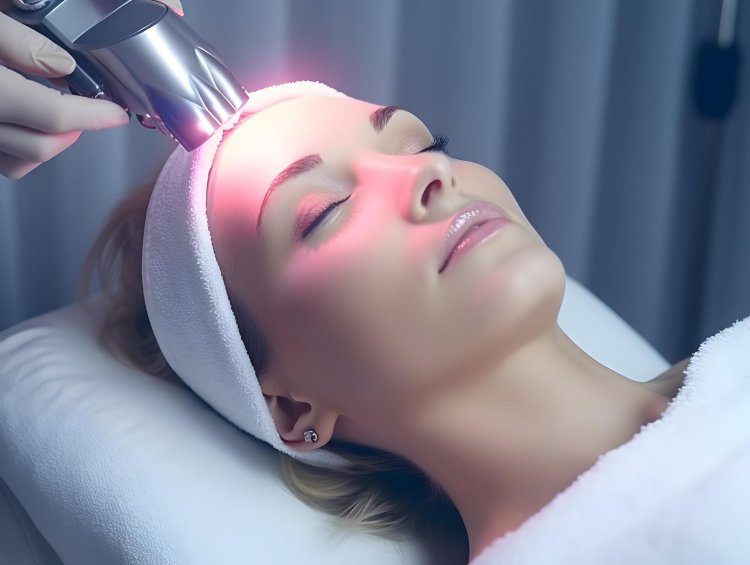Fractional Laser: A Journey Through Light and Skin Rejuvenation
Skin rejuvenation has always been a hot topic in the realm of dermatology and aesthetics. Among the various methods that have surfaced over the years, fractional laser technology stands out for its innovation and effectiveness. This article delves into the intricacies of fractional laser treatment, exploring its science, benefits, and considerations.

The Science Behind Fractional Laser Technology
Fractional laser treatment represents a significant advancement in laser therapy for skin rejuvenation. The concept revolves around delivering laser energy in a fractionated manner, meaning the laser beam is split into thousands of tiny, microthermal zones that treat a fraction of the skin at a time. This method ensures a portion of the skin remains untreated, promoting faster healing and reduced downtime compared to traditional laser treatments.
Types of Fractional Lasers
Fractional lasers can be broadly categorized into ablative and non-ablative lasers. Each type has distinct characteristics and applications:
-
Ablative Lasers: These lasers, such as CO2 and Erbium lasers, work by vaporizing the outer layers of the skin. They are highly effective in treating deep wrinkles, scars, and significant skin damage. The treatment typically requires a longer recovery period but offers more dramatic results.
-
Non-Ablative Lasers: These lasers, including fractional Erbium and Nd
lasers, work by heating the underlying skin tissue without removing the outer layers. They are less invasive, have a shorter recovery time, and are suitable for treating mild to moderate skin issues like fine lines, pigmentation, and surface scars.
How Fractional Lasers Work
Fractional lasers create micro-injuries in the skin, which trigger the body’s natural healing process. This process stimulates the production of collagen and elastin, essential proteins for maintaining skin elasticity and firmness. As the skin heals, it becomes smoother, firmer, and more youthful in appearance.
Benefits of Fractional Laser Treatment
The popularity of fractional laser treatment stems from its numerous benefits, making it a preferred choice for many individuals seeking skin rejuvenation.
Precision and Customization
One of the standout features of fractional laser technology is its precision. Dermatologists can tailor the treatment to target specific skin concerns, adjusting the laser’s intensity, depth, and pattern according to the patient’s needs. This customization ensures optimal results with minimal side effects.
Minimal Downtime
Compared to traditional laser resurfacing methods, fractional lasers offer significantly reduced downtime. Since only a fraction of the skin is treated at a time, the surrounding untreated areas aid in faster recovery. Most patients can return to their regular activities within a few days.
Versatility in Treating Various Skin Conditions
Fractional lasers are versatile and can address a wide range of skin issues, including:
- Wrinkles and fine lines
- Acne and surgical scars
- Pigmentation irregularities
- Sun damage
- Skin laxity
- Stretch marks
Enhanced Safety Profile
The fractionated nature of the treatment reduces the risk of complications commonly associated with laser therapy, such as hyperpigmentation, scarring, and infection. Moreover, the technology allows for precise control over the depth and intensity of the laser, ensuring a safer and more controlled treatment.
What to Expect During and After Treatment
Understanding what to expect during and after fractional laser treatment can help alleviate anxiety and prepare patients for the process.
The Treatment Process
Before the procedure, a thorough consultation with a dermatologist is essential. The dermatologist will assess the patient’s skin type, concerns, and medical history to determine the most suitable treatment plan.
During the treatment, the skin is cleansed, and a topical anesthetic may be applied to minimize discomfort. The dermatologist then uses the fractional laser device to deliver precise laser energy to the targeted areas. The procedure typically takes between 15 to 60 minutes, depending on the size and number of areas being treated.
Post-Treatment Care and Recovery
After the treatment, patients may experience redness, swelling, and a sensation similar to a sunburn. These effects are temporary and usually subside within a few days. Proper post-treatment care is crucial for optimal results and includes:
- Keeping the skin hydrated and moisturized
- Avoiding sun exposure and using a broad-spectrum sunscreen
- Following the dermatologist’s recommendations for skincare products and routines
- Avoiding picking or scratching the treated areas
Long-Term Results
The results of fractional laser treatment are not immediate and gradually appear as the skin heals and new collagen forms. Most patients notice significant improvements within a few weeks, with continued enhancement over several months. The longevity of the results can be maintained with proper skincare and occasional maintenance treatments as recommended by the dermatologist.
Potential Risks and Considerations
While fractional laser treatment is generally safe, it is important to be aware of potential risks and considerations to make an informed decision.
Common Side Effects
Common side effects of fractional laser treatment include:
- Redness and swelling
- Mild discomfort or pain during and after the procedure
- Temporary changes in skin color, such as hyperpigmentation or hypopigmentation
These side effects are usually mild and resolve on their own within a few days to weeks.
Rare Complications
Although rare, more serious complications can occur, such as:
- Scarring
- Infection
- Prolonged redness or swelling
- Persistent changes in skin color
These complications can often be minimized by choosing a qualified and experienced dermatologist and following pre- and post-treatment care instructions diligently.
Who is an Ideal Candidate?
Fractional laser treatment is suitable for many individuals, but certain factors can influence its effectiveness and safety.
Ideal Candidates
Ideal candidates for fractional laser treatment typically:
- Have realistic expectations about the results
- Are in good overall health
- Have mild to moderate skin concerns that can be addressed with laser therapy
- Are willing to follow pre- and post-treatment care instructions
Contraindications
Certain conditions and factors may contraindicate fractional laser treatment, including:
- Active skin infections or inflammatory conditions (e.g., eczema, psoriasis)
- Recent use of isotretinoin (Accutane)
- Pregnancy or breastfeeding
- History of keloid scarring
- Certain medical conditions that affect healing (e.g., uncontrolled diabetes)
A thorough consultation with a dermatologist is essential to determine if fractional laser treatment is appropriate and safe for each individual.
Preparing for Fractional Laser Treatment
Preparation is key to achieving the best results from fractional laser treatment. Here’s what patients should do before undergoing the procedure.
Consultation and Assessment
A comprehensive consultation with a dermatologist is the first step. During this visit, the dermatologist will:
- Assess the patient's skin type and concerns
- Review the patient's medical history and current medications
- Discuss the expected outcomes, potential risks, and post-treatment care
- Develop a personalized treatment plan
Pre-Treatment Care
In the weeks leading up to the procedure, patients should follow these guidelines:
- Avoid Sun Exposure: Limit sun exposure and use a broad-spectrum sunscreen to protect the skin.
- Discontinue Certain Products: Stop using products that can increase skin sensitivity, such as retinoids, glycolic acid, and certain acne medications, as advised by the dermatologist.
- Stay Hydrated: Maintain good hydration and follow a healthy diet to support skin health.
- Avoid Smoking and Alcohol: Refrain from smoking and excessive alcohol consumption, as these can impair healing.
The Evolution of Fractional Laser Technology
Fractional laser technology has evolved significantly since its inception, driven by advances in laser engineering and a deeper understanding of skin biology.
Early Developments
The concept of fractional photothermolysis was first introduced in the early 2000s. This breakthrough marked a shift from traditional, fully ablative laser treatments to a fractionated approach, offering a balance between efficacy and safety.
Technological Advancements
Over the years, several advancements have been made to enhance the precision, safety, and effectiveness of fractional lasers:
- Hybrid Fractional Lasers: Combining ablative and non-ablative wavelengths, hybrid lasers offer the benefits of both types in a single treatment, allowing for deeper penetration and improved results.
- Fractional Radiofrequency (RF) Devices: These devices use radiofrequency energy instead of laser light to create microthermal zones, offering an alternative for patients with darker skin tones who may be more prone to pigmentation changes.
- Enhanced Cooling Systems: Modern fractional lasers are equipped with advanced cooling systems to minimize discomfort and protect the outer skin layers during treatment.
Fractional Laser vs. Other Skin Rejuvenation Methods
To understand the unique benefits of fractional laser treatment, it's essential to compare it with other popular skin rejuvenation methods.
Chemical Peels
Chemical peels involve applying a chemical solution to exfoliate and rejuvenate the skin. While effective for superficial skin issues, chemical peels lack the precision and depth control of fractional lasers. They also require more recovery time and carry a higher risk of side effects in some cases.
Microneedling
Microneedling uses fine needles to create micro-injuries in the skin, stimulating collagen production. It’s less invasive than fractional lasers but generally less effective for deep wrinkles, scars, and significant skin damage. Microneedling may be combined with fractional laser treatment for enhanced results.
Intense Pulsed Light (IPL) Therapy
IPL therapy uses broad-spectrum light to target pigmentation and vascular issues. It’s effective for treating surface-level concerns like sunspots and rosacea but doesn’t penetrate as deeply as fractional lasers, making it less suitable for deep wrinkles and scars.
Dermabrasion
Dermabrasion involves mechanically exfoliating the outer skin layers. It’s effective for surface irregularities but lacks the precision and control of fractional lasers, leading to a higher risk of uneven results and longer recovery times.
Future Prospects of Fractional Laser Technology
The future of fractional laser technology looks promising, with ongoing research and development aimed at enhancing its efficacy and safety.
Emerging Technologies
- Picosecond Lasers: These lasers deliver ultra-short pulses, reducing thermal damage and improving precision. They hold promise for treating pigmentation issues and enhancing skin texture.
- AI and Machine Learning: Integrating artificial intelligence and machine learning into laser devices can enable real-time adjustments and personalized treatment plans, optimizing outcomes and safety.
- Combination Therapies: Combining fractional lasers with other modalities, such as PRP (Platelet-Rich Plasma) or stem cell therapy, may offer synergistic benefits, enhancing skin rejuvenation and healing.
Expanding Applications
Fractional laser technology is also being explored for new applications beyond skin rejuvenation, such as:
- Scar Treatment: Advanced fractional lasers can improve the appearance of surgical and traumatic scars, offering hope for patients with significant scarring.
- Stretch Mark Reduction: Early studies indicate that fractional lasers can effectively reduce the appearance of stretch marks, a common concern for many individuals.
- Skin Tightening: Combining fractional lasers with other skin-tightening technologies, such as RF, can provide non-surgical solutions for skin laxity.
Understanding fractional laser technology can empower individuals to make informed decisions about their skin rejuvenation journey. The combination of precision, minimal downtime, and versatility makes fractional lasers a compelling option for those seeking to enhance their skin’s appearance and health.
Fractional laser technology has revolutionized the field of dermatology, offering a powerful and versatile tool for skin rejuvenation. By delivering precise, fractionated laser energy, these treatments promote collagen production, improve skin texture, and address a wide range of skin concerns with minimal downtime and enhanced safety. As the technology continues to evolve, fractional lasers will likely become even more effective and accessible, helping more individuals achieve their skin goals. If you’re considering fractional laser treatment, consult with a qualified dermatologist to explore how this innovative technology can benefit your skin.
Disclaimer: The information provided in this article is for educational purposes only and should not be considered medical advice. If you have any health concerns or are experiencing symptoms, it is important to consult with a healthcare professional, such as a doctor or clinic, for proper diagnosis and treatment. Always seek the advice of your doctor or other qualified health provider with any questions you may have regarding a medical condition. Do not disregard professional medical advice or delay in seeking it because of something you have read in this article.
What's Your Reaction?





















